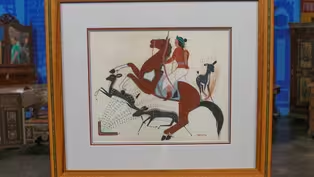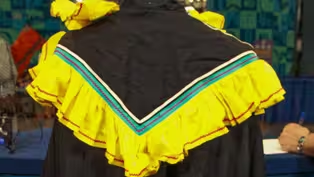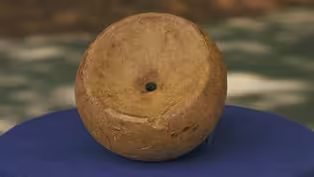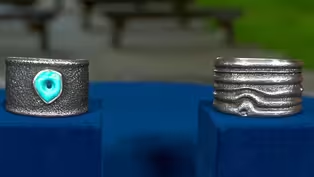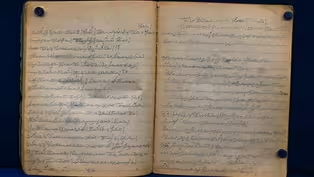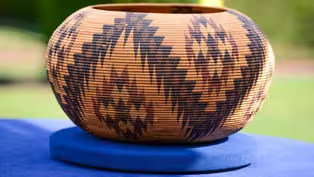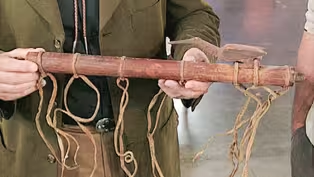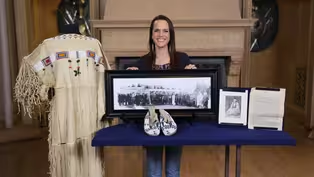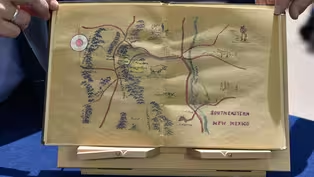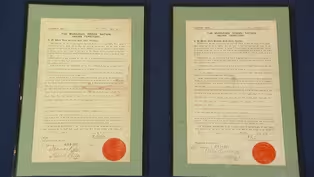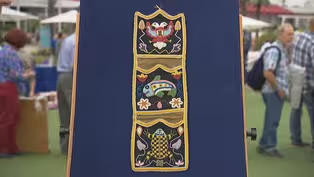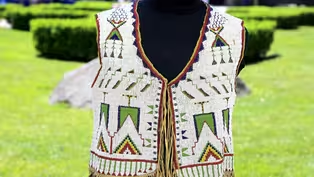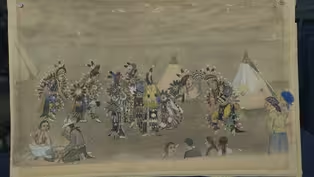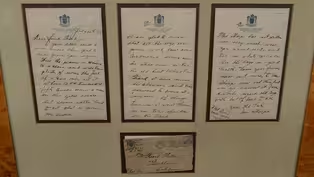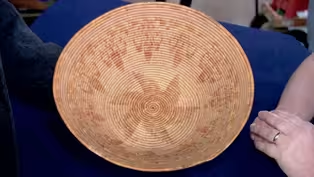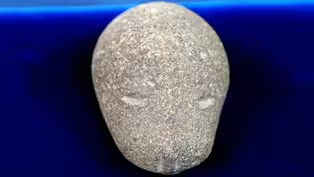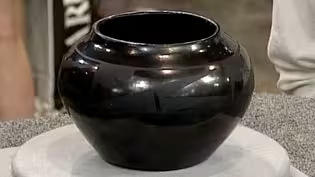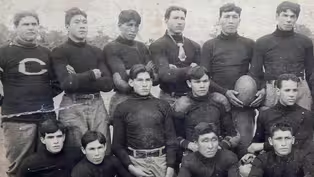
Appraisal: Navajo Transitional Pictorial Weaving, ca. 1890
Clip: Season 28 Episode 23 | 2m 29sVideo has Closed Captions
Appraisal: Navajo Transitional Pictorial Weaving, ca. 1890
Watch Joan Caballero appraise a Navajo transitional pictorial weaving, ca. 1890, in Celebrating Native American Heritage.
Problems playing video? | Closed Captioning Feedback
Problems playing video? | Closed Captioning Feedback
Funding for ANTIQUES ROADSHOW is provided by Ancestry and American Cruise Lines. Additional funding is provided by public television viewers.

Appraisal: Navajo Transitional Pictorial Weaving, ca. 1890
Clip: Season 28 Episode 23 | 2m 29sVideo has Closed Captions
Watch Joan Caballero appraise a Navajo transitional pictorial weaving, ca. 1890, in Celebrating Native American Heritage.
Problems playing video? | Closed Captioning Feedback
How to Watch Antiques Roadshow
Antiques Roadshow is available to stream on pbs.org and the free PBS App, available on iPhone, Apple TV, Android TV, Android smartphones, Amazon Fire TV, Amazon Fire Tablet, Roku, Samsung Smart TV, and Vizio.
Buy Now
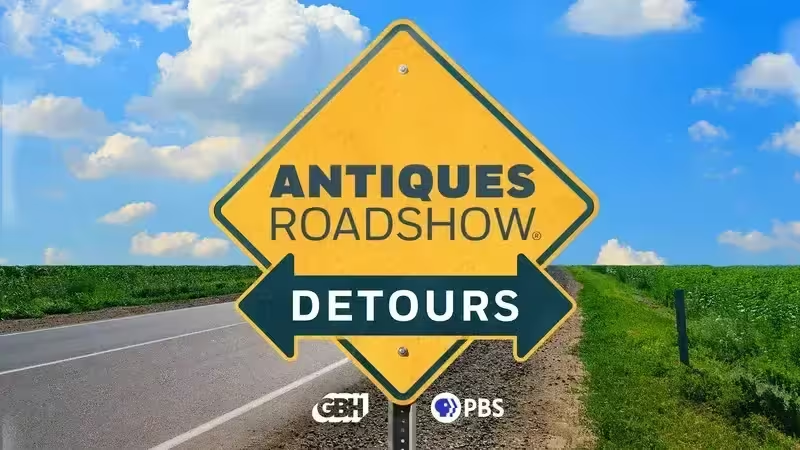
ANTIQUES ROADSHOW DETOURS
Ever wondered what happens to the treasures featured on America’s beloved ANTIQUES ROADSHOW after the cameras leave town? Host Adam Monahan tracks down the juicy afterlives of your favorite finds from PBS’s hit series.Providing Support for PBS.org
Learn Moreabout PBS online sponsorshipGUEST: In the very early '60s, my grandfather had passed away, and my father made me and some of the other family members go to his house to clean the basement out.
And this, along with a lot of other, we thought, junk was just laying on the floor in the basement.
And it was gonna be thrown away.
And I, being 12, 13 years old, I dragged it home.
And I think it's a Navajo rug.
Later years, I learned that my grandfather and his brother, they were both architects.
And they worked for different mapping companies, and they dealt with railroads, and I'm sure that's where it came from.
APPRAISER: What you have here is indeed a Navajo weaving.
After the Navajo were weaving garments for their own personal use, and before the actual rug period started, in about 1905 or so, there was a, a period of about 20 or so years of transitional weaving.
The yarns are homespun yarns.
The dark brown is natural yarn color, and the cream is a natural yarn color.
GUEST: Right.
APPRAISER: All the red within the weaving is actually a commercial synthetic dye...
GUEST: Okay.
APPRAISER: ...which they used commonly in that timeframe.
It was woven on an upright loom, and it's very pictorial.
One of the best icons of the American West is pictured right in the center of your weaving, the steam locomotive.
You see the barber pole striping right here used for the train tracks, as well as for these design elements right here, are taken from early Navajo wearing blanket designs.
This weaving is from the Crystal area on the Navajo reservation, which is on the western edge of the state of New Mexico.
This weaving dates to about 1890.
You have some spotting going on here.
You have some red dye that has bled into the weaving.
Because of the condition, this particular textile would probably realize a value at auction between $8,000 and $10,000.
GUEST: Eight and ten?
APPRAISER: Yes.
If the weaving were to be successfully restored, this weaving could probably realize a value more of $12,000 to $15,000...
GUEST: Okay.
APPRAISER: ...on today's market.
GUEST: Okay.
Appraisal: Narciso Abeyta (Ha So De) Painting, ca. 1935
Video has Closed Captions
Clip: S28 Ep23 | 2m 41s | Appraisal: Narciso Abeyta (Ha So De) Painting, ca. 1935 (2m 41s)
Appraisal: Seminole Circuit Court Judge's Robe, ca. 1955
Video has Closed Captions
Clip: S28 Ep23 | 23s | Appraisal: Seminole Circuit Court Judge's Robe, ca. 1955 (23s)
Appraisal: Mississippian Granite Discoidal, ca. 1000 - 1500
Video has Closed Captions
Clip: S28 Ep23 | 1m 47s | Appraisal: Mississippian Granite Discoidal, ca. 1000 - 1500 (1m 47s)
Appraisal: 1970 Charles Loloma Sterling Silver Bracelets
Video has Closed Captions
Clip: S28 Ep23 | 3m | Appraisal: Charles Loloma Sterling Silver Bracelets, ca. 1970 (3m)
Appraisal: Yup'ik Language Manuscript, ca. 1895
Video has Closed Captions
Clip: S28 Ep23 | 3m 19s | Appraisal: Yup'ik Language Manuscript, ca. 1895 (3m 19s)
Appraisal: Carrie Bethel Basket, ca. 1958
Video has Closed Captions
Clip: S28 Ep23 | 5m 1s | Appraisal: Carrie Bethel Basket, ca. 1958 (5m 1s)
Appraisal: Plains Indian Courting Flute, ca. 1870
Video has Closed Captions
Clip: S28 Ep23 | 1m 44s | Appraisal: Plains Indian Courting Flute, ca. 1870 (1m 44s)
Appraisal: Ruth Muskrat Bronson Archive, ca. 1923
Video has Closed Captions
Clip: S28 Ep23 | 4m 58s | Appraisal: Ruth Muskrat Bronson Archive, ca. 1923 (4m 58s)
Appraisal: 'A Courier in New Mexico' book 1936
Video has Closed Captions
Clip: S28 Ep23 | 3m 37s | Appraisal: 'A Courier in New Mexico' Book, ca. 1936 (3m 37s)
Appraisal: 1903 & 1905 Muskogee Creek Nation Allotment Deeds
Video has Closed Captions
Clip: S28 Ep23 | 1m 56s | Appraisal: 1903 & 1905 Muskogee Creek Nation Allotment Deeds (1m 56s)
Appraisal: Tlingit Wall Pocket, ca. 1880
Video has Closed Captions
Clip: S28 Ep23 | 1m 22s | Appraisal: Tlingit Wall Pocket, ca. 1880 (1m 22s)
Appraisal: Sioux Beaded Vest, ca. 1876
Video has Closed Captions
Clip: S28 Ep23 | 3m 28s | Appraisal: Sioux Beaded Vest, ca. 1876 (3m 28s)
Appraisal: Ernest Spybuck Painting, ca. 1915
Video has Closed Captions
Clip: S28 Ep23 | 25s | Appraisal: Ernest Spybuck Painting, ca. 1915 (25s)
Appraisal: 1933 Jim Thorpe Handwritten Letter
Video has Closed Captions
Clip: S28 Ep23 | 4m 35s | Appraisal: 1933 Jim Thorpe Handwritten Letter (4m 35s)
Appraisal: Mission Indian Basket, ca. 1920
Video has Closed Captions
Clip: S28 Ep23 | 1m 3s | Appraisal: Mission Indian Basket, ca. 1920 (1m 3s)
Appraisal: Woodlands Carved Ash Burl Bowl, ca. 1800
Video has Closed Captions
Clip: S28 Ep23 | 3m 21s | Appraisal: Woodlands Carved Ash Burl Bowl, ca. 1800 (3m 21s)
Appraisal: Aleut Stone Oil Lamp
Video has Closed Captions
Clip: S28 Ep23 | 3m 53s | Appraisal: Aleut Unungan Stone Oil Lamp (3m 53s)
Appraisal: Hopi Pottery Seed Jar, ca. 1908
Video has Closed Captions
Clip: S28 Ep23 | 33s | Appraisal: Hopi Pottery Seed Jar, ca. 1908 (33s)
Appraisal: Maria Martinez Pot, ca. 1925
Video has Closed Captions
Clip: S28 Ep23 | 2m 11s | Appraisal: Maria Martinez Pot, ca. 1925 (2m 11s)
Appraisal: Carlisle Indian School Archive, ca. 1910
Video has Closed Captions
Clip: S28 Ep23 | 2m 46s | Appraisal: Carlisle Indian School Archive, ca. 1910 (2m 46s)
Providing Support for PBS.org
Learn Moreabout PBS online sponsorship
- Home and How To

Hit the road in a classic car for a tour through Great Britain with two antiques experts.













Support for PBS provided by:
Funding for ANTIQUES ROADSHOW is provided by Ancestry and American Cruise Lines. Additional funding is provided by public television viewers.


